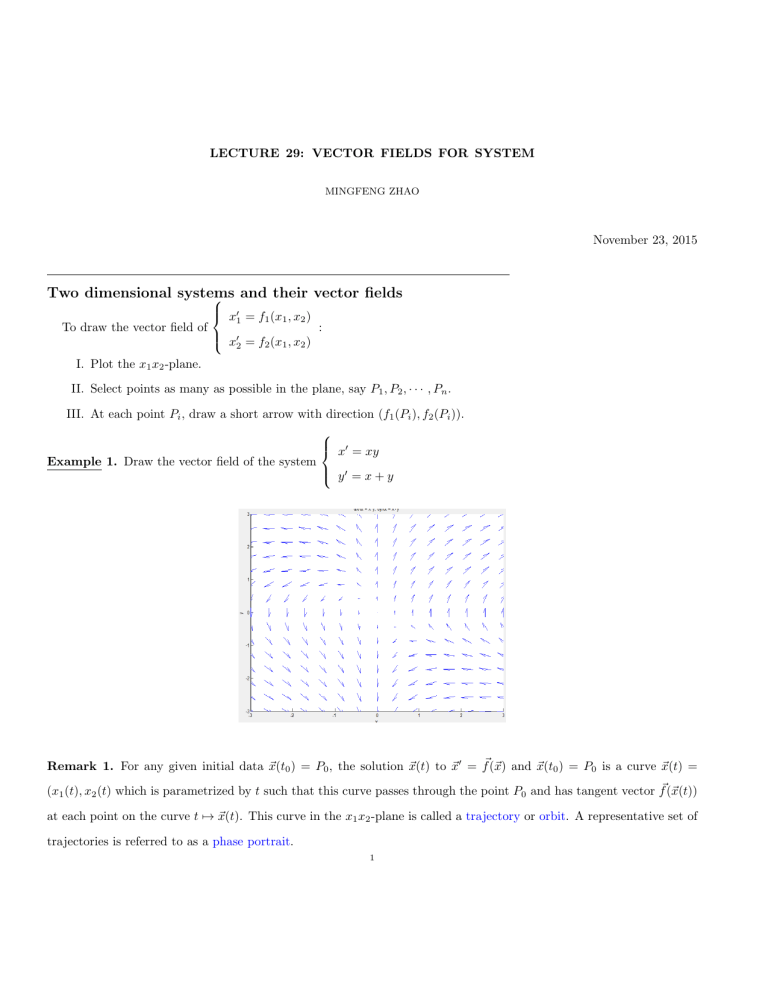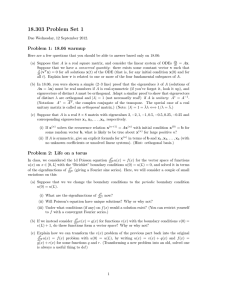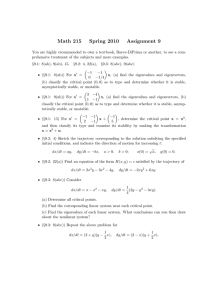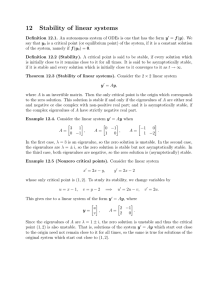Two dimensional systems and their vector fields
advertisement

LECTURE 29: VECTOR FIELDS FOR SYSTEM MINGFENG ZHAO November 23, 2015 Two dimensional systems and their vector fields To draw the vector field of x0 = f1 (x1 , x2 ) 1 : x02 = f2 (x1 , x2 ) I. Plot the x1 x2 -plane. II. Select points as many as possible in the plane, say P1 , P2 , · · · , Pn . III. At each point Pi , draw a short arrow with direction (f1 (Pi ), f2 (Pi )). x0 = xy Example 1. Draw the vector field of the system y0 = x + y Remark 1. For any given initial data ~x(t0 ) = P0 , the solution ~x(t) to ~x0 = f~(~x) and ~x(t0 ) = P0 is a curve ~x(t) = (x1 (t), x2 (t) which is parametrized by t such that this curve passes through the point P0 and has tangent vector f~(~x(t)) at each point on the curve t 7→ ~x(t). This curve in the x1 x2 -plane is called a trajectory or orbit. A representative set of trajectories is referred to as a phase portrait. 1 2 MINGFENG ZHAO Notice that for the trajectories, since the trajectory is a curve in the x1 x2 plane, so if we think the trajectory locally, than x2 (or x1 ) will be a function of x1 (or x2 ), that is, x2 (t) = x2 (x1 (t)), take the derivative with respect to t, by the chain rule, we have dx2 dx2 dx1 = · . dt dx1 dt So (x1 , x2 ) will satisfy dx2 = dx1 (1) dx2 dt dx1 dt = x02 (t) f2 (x1 , x2 ) = . 0 x1 (t) f1 (x1 , x2 ) So to draw the trajectories by plotting all points (x1 (t), x2 (t)) for a certain range of t, we should solve the first order differential equation (1). Definition 1. Consider the autonomous system ~x0 = f~(~x), let ~a be a constant vector, we say that ~a is a critical point of the autonomous system ~x0 = f~(~x) if f~(~a) = 0. In this case, we say that ~x(t) ≡ ~a is an equilibrium solution to the system ~x0 = f~(~x). Example 2. For the system x0 = sin(x) . Find all critical points. y 0 = sin2 (x) + y 2 Solve sin(x) = 0 and sin2 (x) + y 2 = 0, then we get sin(x) = 0, y = 0. So we have x = kπ for k ∈ Z and y = 0. So all critical points of the system x0 = sin(x) are (kπ, 0) with y 0 = sin2 (x) + y 2 k ∈ Z. Definition 2. Let ~a be a critical point of the system ~x0 = f~(~x), that is, f~(~a) = 0. Then I. We say that the critical point ~a is stable if for any given > 0, there exists some δ > 0 such that for any solutions ~x(t) to the initial value problem ~x0 = f~(~x), ~x(0) = ~x0 with |~x0 − ~a| < δ, we have |~x(t) − ~x0 | < , for all t ≥ 0. II. We say that the critical point ~a is unstable if ~a is not stable. III. We say that the critical point ~a is asymptotically stable if ~a is stable, and there exists some δ > 0 such that for any solutions ~x(t) to the initial value problem ~x0 = f~(~x), ~x(0) = ~x0 with |~x0 − ~a| < δ, we have lim ~x(t) = ~a. t→∞ LECTURE 29: VECTOR FIELDS FOR SYSTEM 3 a In the following, let A = c b be a 2 × 2 matrix, λ1 and λ2 be two nonzero different eigenvalues of A. Notice d that det(A − λI2 ) = λ2 − (a + d)λ + (ad − bc). Since λ1 6= 0 and λ2 6= 0, then det A 6= 0, which implies that the origin (0, 0) is the only critical point to the system ~x0 = A~x. For the behaviors of solutions to ~x0 = A~x near the origin (0, 0), we have the following six cases: Eigenvalues Type of Critical Point (0,0) Stability I. λ1 , λ2 are real and both positive source unstable II. λ1 , λ2 are real and both negative sink asymptotically stable III. λ1 , λ2 are real and opposite signs saddle point unstable IV. λ1 , λ2 are complex with positive real part spiral source unstable V. λ1 , λ2 are complex with negative real part spiral sink asymptotically stable VI. λ1 , λ2 are complex with zero real part center point stable v1 Remark 2. Let λ be an eigenvalue of A and ~v = be an eigenvector corresponding to λ, then the eigenvalue v2 λt v1 v1 e method solution to ~x0 = A~x is ~x(t) = eλt~v = eλt = , that is, x1 (t) = v1 eλt and x2 (t) = v2 eλt . So in λt v2 v2 e v1 x1 = , that is, v2 x1 − v1 x2 = 0 which is a straight line and passing (0, 0) in the x1 x2 -plane. the x1 x2 -plane, we have x2 v2 Now let’s look at each case separately. I. Both eigenvalues λ1 and λ2 are real and positive, then the vector field of ~x0 = A~x is like a source with arrows coming out from the origin, we say the critical point (0, 0) is a source and unstable. 1 1 Example 3. Let A = , then it’s easy to know that λ1 = 1 and λ2 = 2 are two eigenvalues of A, and 0 2 1 1 ~v1 = and ~v2 = are eigenvectors corresponding to λ1 = 1 and λ2 = 2, respectively. So the general 1 0 solution to ~x0 = A~x is: 1 1 2t ~x(t) = C1 et + C2 e . 0 1 4 MINGFENG ZHAO Figure 1. Example source vector field with eigenvectors and solutions II. Both eigenvalues λ1 and λ2 are real and negative, then the vector field of ~x0 = A~x is like a sink with arrows pointing to the origin, we say the critical point (0, 0) is a sinkand asymptotically stable. −1 Example 4. Let A = 0 1 A, and ~v1 = and ~v2 = 0 −1 , then it’s easy to know that λ1 = −1 and λ2 = −2 are two eigenvalues of −2 1 are eigenvectors corresponding to λ1 = −1 and λ2 = −2, respectively. So 1 the general solution to ~x0 = A~x is: 1 1 ~x(t) = C1 e−t + C2 e−2t . 1 0 Figure 2. Example sink vector field with eigenvectors and solutions LECTURE 29: VECTOR FIELDS FOR SYSTEM 5 III. Both eigenvalues λ1 and λ2 are real, one is positive, and the other is negative, then we reverse the arrows on the line corresponding to the negative eigenvalue, we say the critical point (0, 0) is a saddle point and unstable 1 1 Example 5. Let A = , then it’s easy to know that λ1 = 1 and λ2 = −2 are two eigenvalues of A, 0 −2 1 1 and ~v1 = are eigenvectors corresponding to λ1 = 1 and λ2 = −2, respectively. So the and ~v2 = −3 0 general solution to ~x0 = A~x is: 1 1 −2t ~x(t) = C1 et . + C2 e −3 0 Figure 3. Example saddle vector field with eigenvectors and solutions Problems you can do: Lebl’s Book [2]: All Exercises on Page 114. Braun’s Book [1]: All exercises on Page 383, Page 384 and Page 385. Read all materials in Section 4.2. References [1] Martin Braun. Differential Equations and Their Applications: An Introduction to Applied Mathematics. Springer, 1992. [2] Jiri Lebl. Notes on Diffy Qs: Differential Equations for Engineers. Createspace, 2014. Department of Mathematics, The University of British Columbia, Room 121, 1984 Mathematics Road, Vancouver, B.C. Canada V6T 1Z2 E-mail address: mingfeng@math.ubc.ca






